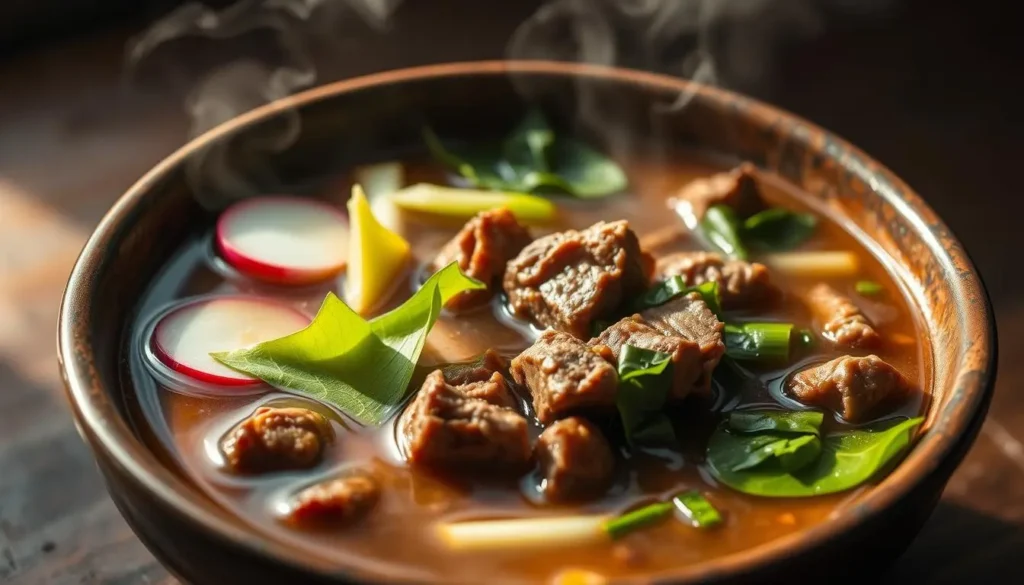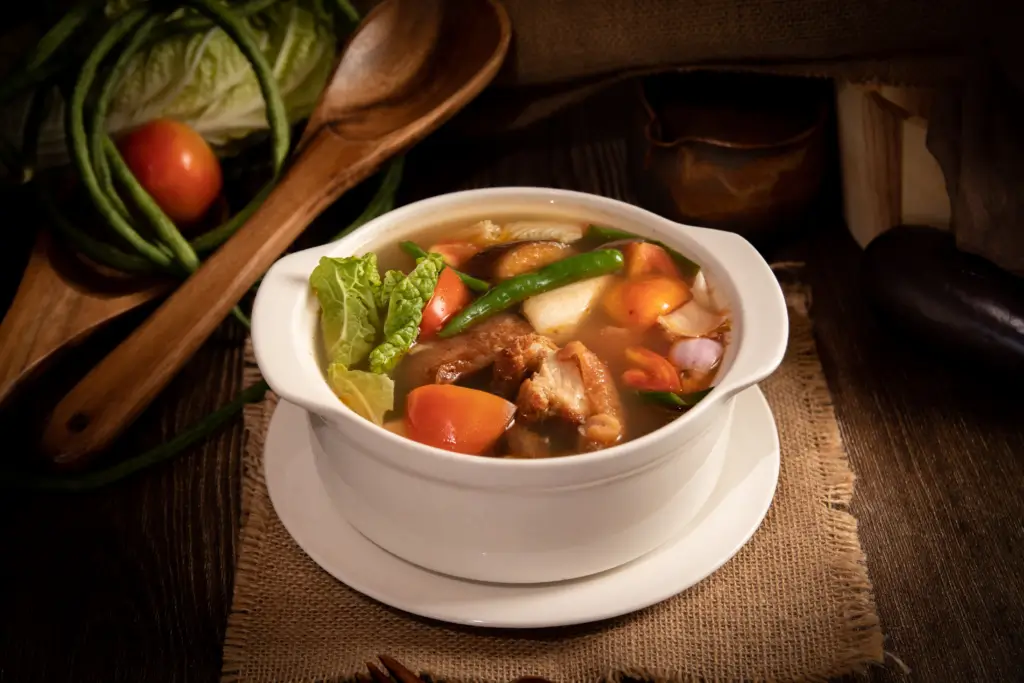What Makes Filipino Beef Sinigang Irresistible Tast?
Picture a dish that comforts your soul and excites your palate with a harmonious blend of tangy and savory flavors. Filipino Beef Sinigang has been a staple in many Filipino households, and for good reason.
This traditional Filipino Beef Sinigang is more than just a meal; it’s an experience that brings people together. The unique blend of ingredients, including tamarind broth and various vegetables, creates a flavor profile that is both comforting and refreshing.
Table of Contents
Key Takeaways
- This time-honored delicacy is deeply rooted in Filipino tradition and cultural heritage
- Its unique blend of ingredients creates a flavor profile that is both comforting and refreshing
- This beloved soup is a staple in many households and is often served at family gatherings
- The preparation is highly versatile and can be made with various proteins and vegetables
- The recipe reflects Filipino culture and its love for sour and savory flavors
The Soul of Filipino Cuisine
This delicacy is more than just a meal; it’s a reflection of Filipino culture and its rich culinary heritage. This cherished preparation captures the heart of Filipino cuisine, uniting people through its distinctive and comforting flavors.
A Beloved National Dish
This soup is a staple in Filipino cuisine, cherished by locals and loved by visitors. You can find it in almost every Filipino household, and it’s a common feature in restaurants serving traditional Filipino dishes.
The Distinctive Sour Profile
The distinctive sour taste sets this preparation apart from others sinigang dishes. This tangy soup is achieved through various souring agents like tamarind, guava, or tomatoes. You can adjust the level of sourness to your taste, making it versatile for different palates.
| Key Ingredients | Role in the Recipe | Contribution to Flavor |
|---|---|---|
| Tamarind or other souring agents | Provides the sour taste | Creates the distinctive tangy profile |
| Vegetables (e.g., tomatoes, spinach) | Adds texture and flavor | Enhances the overall taste experience |
| Protein (e.g., beef, fish, or shrimp) | Serves as the main protein source | Adds depth and richness to the dish |
The History and Cultural Significance
The origins date back to pre-colonial times, with its sour taste influenced by various Filipino tribes. The preparation has evolved over time, incorporating different souring agents like tamarind, guava, or kamias, making it versatile across households.
As you travel across the Philippines, you’ll notice many regional variations. Some regions prefer using different types of fish or meat, while others add unique ingredients to create their own twist on the classic preparation.
Authentic Filipino Beef Sinigang Recipe
To make an authentic version, you’ll need the right ingredients and a bit of patience. This traditional dish is recognized for its tangy and savory flavor profile.

Complete Ingredients List
The ingredients for this Filipino delicacy are crucial to its flavor and authenticity. Traditional ingredients include:
- 1 pound beef bones or beef shank
- 2 tablespoons fish sauce or salt
- 2 cups water
- ½ cup tamarind soup base or 2 to 3 pieces of fresh tamarind pods
- 1 onion, quartered
- 2 cloves garlic, minced
- 1 pound beef, cut into bite-sized pieces
- 2 tomatoes, sliced
- 1 cup mix (optional)
- Various vegetables such as taro, spinach, or green beans
Traditional Ingredients
Traditional recipes rely on ingredients like tamarind or kamias for the distinctive sour taste. The use of tamarind is particularly significant as it provides the soup with its characteristic flavor.
Ingredient Substitutions
For those who may not have access to traditional ingredients, there are substitutions available. For example, if fresh tamarind is not available, you can use a tamarind soup base or prepared mix as an alternative.
Time Requirements
- Preparation Time: Approximately 20 minutes for chopping vegetables and preparing beef
- Cooking Time: About 1 hour and 30 minutes for boiling beef and cooking vegetables until tender
- Total Time: Allocate about 1 hour and 50 minutes from start to finish
As one chef notes, “The secret to a delicious result lies in patience—giving the flavors time to fully develop and blend.”
Equipment Needed
- A large pot
- A cutting board
- A knife
- A strainer
Step-by-Step Cooking Instructions
Preparing the Beef
- Cut 1 pound of beef into bite-sized pieces
- Season the beef pieces with salt
- Heat 2 tablespoons of oil in a pan over medium heat.
- Sauté the beef until it’s browned
- Remove the beef from the pan and place it aside for later
Creating the Sour Broth Base
- In a large pot, combine 4 cups of water and 2 tablespoons of fish sauce
- Bring the mixture to a boil
- Lower the heat and let it simmer
- Add one packet of mix or tamarind paste to the pot
- Stir until completely dissolved (this crucial ingredient provides the distinctive sour taste)
Adding and Cooking the Vegetables
- Add the browned beef back into the pot with the broth
- Add your choice of vegetables:
- Okra
- Taro
- Eggplant
- Spinach (optional)
- Tomatoes (optional)
- Let the vegetables cook until tender
| Vegetable | Cooking Time |
|---|---|
| Okra | 5 minutes |
| Taro | 10-15 minutes |
| Eggplant | 5-7 minutes |
What Makes This Filipino Dish Unique
This Filipino soup is characterized by its perfect balance of sour, salty, and savory flavors. The tamarind broth provides a tangy base, while ingredients like tomatoes, onions, and various vegetables add depth.
Comparison to Other Asian Sour Soups
This Filipino delicacy has its own distinct charm. Unlike Thai Tom Yum, known for its spicy and sour flavors, this recipe focuses on a more balanced taste profile.
| Dish | Broth Base | Key Flavors | Main Ingredients |
|---|---|---|---|
| Filipino Recipe | Tamarind | Sour, Savory, Salty | Beef, Tomatoes, Various Vegetables |
| Thai Tom Yum | Lime Leaves, Chilies | Spicy, Sour | Shrimp or Chicken, Lemongrass, Chilies |
| Vietnamese Canh Chua | Tamarind or Pineapple | Sour, Sweet, Fishy | Fish, Pineapple, Tomatoes, Various Vegetables |
Chef’s Tips for Perfect Results
Common Mistakes to Avoid
When cooking cooking sinigang na baboy, several common pitfalls can affect the overall flavor:
- Overcooking the beef
- Not balancing the sourness
- Using low-quality ingredients
Adjusting the Sourness to Your Taste
You can adjust the tanginess to match your preference. If you prefer milder sourness, reduce the amount of tamarind or mix. For a tangier taste, mix in extra tamarind or a dash of calamansi.
| Adjustment | Effect |
|---|---|
| Reduce tamarind | Milder sourness |
| Add more tamarind | Tangier flavor |
As Chef Luis once said, “The key to a great result is not just in the ingredients, but in the balance of its flavors.”
Nutritional Information
A typical serving contains approximately 250 calories, with a balance of proteins, carbohydrates, and fats. The beef provides protein, while the vegetables add fiber and vitamins.
The key ingredients offer several health benefits. The tamarind or other souring agents are rich in antioxidants, and the vegetables provide essential vitamins and minerals. The beef contributes to protein intake, supporting muscle health.
Serving and Pairing Suggestions

Traditionally, this delicacy is served with steamed rice. You can also pair it with side dishes like grilled fish or chicken adobo (fried chicken), or even tofu for a vegetarian option.
For beverages, it pairs wonderfully with refreshing drinks such as iced tea or fresh lemonade. A glass of buko juice (young coconut water) can cleanse your palate between spoonfuls.
| Pairing Suggestions | Description |
|---|---|
| Steamed Rice | A traditional pairing that complements the sour flavors |
| Grilled Fish | Adds a smoky flavor that pairs well with the tamarind broth |
| Iced Tea | A refreshing beverage that helps balance the sourness |
Regional Variations
Different regions in the Philippines have their own twist on this dish, using locally available ingredients. Some areas prefer tamarind as the souring agent, while others opt for guava or kamias.
Modern chefs are experimenting with this soup, incorporating international flavors to create fusion dishes. You might find inspired soups with a Korean chili kick or versions that blend Filipino and Mexican flavors.
Storing and Reheating
When storing in the refrigerator, cool it to room temperature first and store in an airtight container for up to 3 days. When reheating, bring it to a boil to ensure food safety.
For longer storage, portion the cooled soup into airtight containers or freezer bags, leaving space for expansion. The soup can be stored in the freezer for up to 3 months. Thaw overnight in the refrigerator, then reheat until hot.
Conclusion: Embracing the Unique Flavors of Filipino Cuisine
This delicacy stands out with its unique blend of tangy and savory flavors. By cooking and savoring this beloved national dish, you’ll gain a deeper appreciation for the cultural heritage and culinary traditions of the Philippines.
The beauty of this Filipino recipe lies in its versatility and the way it brings people together. Whether enjoyed on a special occasion or as a comforting meal on a chilly evening, this sour soup leaves a lasting impression.
Take the first step in embracing Filipino cuisine by cooking up a pot of this traditional preparation. With its rich flavors and cultural significance, this tangy soup is sure to become a staple in your kitchen.
FAQ
What is this dish? It’s a classic Filipino sour soup made with a variety of proteins and vegetables, simmered in a tangy broth typically flavored with tamarind.
What makes it sour? The sour taste comes from ingredients like tamarind, guava, or kamias. You can adjust the sourness by adding more or less of these souring agents.
Can I use different proteins? Yes, it can be made with beef, shrimp,fried chicken or fish. The type of protein used can slightly alter the overall flavor profile.
How do I adjust the sourness? You can adjust by adding more or less souring agent. If too sour, add a little sugar or more broth. If not sour enough, add more tamarind.
Can I make it in advance? Yes, you can make it ahead of time as the flavors meld together. You can refrigerate or freeze it and then reheat when ready to serve.






